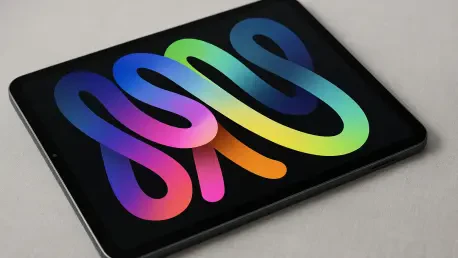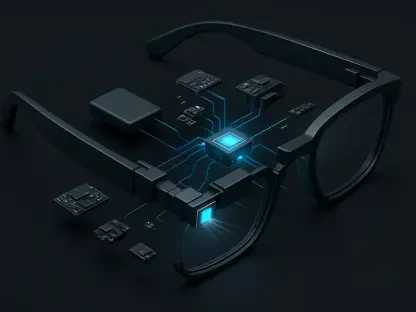In a world where tablets are increasingly becoming go-to devices for work, play, and everything in between, finding the right balance of performance and price can be a daunting task for many consumers looking to upgrade or invest in a new gadget. Enter the iPad Air M3, a device that has quickly captured attention as a potential game-changer in the midrange tablet segment with its sleek design, powerful M3 processor, and a price point that sits comfortably between Apple’s budget-friendly iPad (A16) and the premium iPad Pro (M4). Aimed at users who want high-end features without breaking the bank, this tablet promises to cater to students, creatives, and professionals alike. Whether the goal is to replace a laptop or simply enjoy a top-tier entertainment experience, the iPad Air M3 positions itself as a versatile contender. This exploration will uncover what sets it apart in a crowded market, diving deep into its design, capabilities, and how it measures up against competitors.
Unpacking the Core Strengths
Design That Impresses
The iPad Air M3 immediately stands out with its meticulously crafted build, offering a blend of style and practicality that’s hard to overlook in the midrange category. Weighing a mere 1.01 pounds and measuring just 0.24 inches thick, this tablet is a champion of portability, slipping effortlessly into a backpack or even a larger pocket for those constantly on the move. The anodized aluminum casing, available in understated metallic shades, exudes a premium feel while proving resilient against everyday wear and tear like minor bends or scratches during testing. However, protecting the screen with a cover or film is recommended to maintain its flawless look over time. Beyond aesthetics, this design prioritizes user comfort, making long usage sessions feel less cumbersome compared to bulkier alternatives.
Another aspect worth highlighting is the thoughtful integration of modern connectivity options that enhance the tablet’s usability in diverse scenarios. With features like Wi-Fi 6E for lightning-fast internet, Bluetooth 5.3 for seamless pairing with peripherals, and a USB-C port supporting DisplayPort for external display connections, the iPad Air M3 ensures users stay connected and productive wherever they are. This focus on blending form with function reflects a deep understanding of contemporary needs, whether it’s mirroring content to a larger screen for presentations or simply enjoying a clutter-free wireless experience. Such versatility in a lightweight package makes this device a reliable companion for both casual and professional environments.
Performance and Display Prowess
When it comes to raw power, the iPad Air M3 delivers in spades, thanks to the cutting-edge M3 chip paired with an 8-core CPU, a 9-core GPU, and 8 GB of RAM. This combination ensures that tasks ranging from intensive multitasking to running graphically demanding games like Genshin Impact are handled with remarkable ease and speed. Applications open almost instantaneously, and features such as Stage Manager allow for smooth navigation between multiple windows, mimicking a desktop-like experience. Notably, even during extended periods of heavy use, the tablet manages heat effectively, avoiding discomfort or performance throttling that can plague lesser devices. For the majority of users, this level of capability far exceeds daily requirements.
Equally impressive is the visual experience offered by the 10.86-inch Liquid Retina LCD display, which brings content to life with vibrant colors and crisp details through a wide P3 color gamut. Achieving a brightness of 500 nits, the screen remains visible even under direct sunlight, while an anti-reflective coating minimizes glare for comfortable viewing in various lighting conditions. Although it lacks the OLED technology and adaptive refresh rates found in the iPad Pro, the display quality remains exceptional for the price bracket, catering admirably to activities like streaming high-definition videos or digital sketching. This balance of performance and visual fidelity underscores why the iPad Air M3 is a standout choice for those prioritizing both work and entertainment.
Exploring Features and Market Fit
Software Capabilities and Productivity Tools
Delving into the software ecosystem, the iPad Air M3 runs on iOS, arriving with a suite of preinstalled applications like iWork and iMovie that cater to both productivity and creative pursuits straight out of the box. The operating system’s latest updates, including iOS 26, introduce advanced multitasking options such as Stage Manager and full windowed multitasking, pushing the device closer to functioning as a true laptop alternative for many users. This capability is particularly beneficial for managing complex workflows or juggling multiple projects simultaneously. However, the base storage of 128 GB might feel restrictive for those dealing with large files or extensive app libraries, prompting consideration of higher-capacity models for heavier usage needs.
Further enhancing its productivity potential is the compatibility with accessories like the Apple Pencil Pro and Magic Keyboard, though these are sold separately and add to the overall cost. These tools transform the tablet into a powerful workstation, ideal for tasks ranging from detailed note-taking to drafting professional documents or creating digital art with precision. Such flexibility ensures that the iPad Air M3 can adapt to a wide array of user demands, from academic settings to creative industries. This robust software foundation, combined with optional hardware enhancements, positions the device as a compelling option for anyone seeking a versatile and efficient tool for getting things done.
Battery Life and Practical Features
On the battery front, the iPad Air M3 offers dependable performance that aligns well with the demands of a typical day, providing around 9.5 hours of continuous video playback, which is very close to Apple’s claimed 10-hour lifespan. Accompanied by a 20W USB-C adapter, charging speeds are reasonable, ensuring minimal downtime even after heavy use. While it doesn’t lead the pack in endurance compared to some competitors boasting longer battery life, this tablet strikes a practical balance for most users who need reliability for work, study, or entertainment without frequent recharges. It’s a solid choice for those who value consistent uptime over extended marathons.
Beyond power, the iPad Air M3 packs additional features that enhance its everyday utility, particularly in communication and media consumption. The 12 MP front camera, equipped with Center Stage technology, dynamically adjusts to keep users centered during video calls, making it a great asset for remote meetings or virtual catch-ups. The rear 12 MP camera, while not groundbreaking, suffices for casual photography or document scanning. Audio output from dual landscape speakers, supporting Dolby Atmos, delivers a satisfactory experience for movies and music, though bass depth is limited due to the slim design. Together, these elements create a well-rounded package that caters to diverse needs without overwhelming with unnecessary complexity.
Measuring Up Against the Field
Standing Within Apple’s Ecosystem
Within Apple’s diverse tablet lineup, the iPad Air M3 carves out a distinct niche by offering a middle ground that appeals to a broad audience seeking quality without the premium cost. Compared to the entry-level iPad (A16), it boasts a noticeably slimmer profile, a superior display with enhanced color accuracy, and significantly more processing power, justifying the price difference for those who need more than basic functionality. This makes it an attractive upgrade for users looking to step up their tablet game without venturing into the high-end territory, balancing cost with advanced features effectively for everyday and semi-professional use.
In contrast, when placed alongside the iPad Pro (M4), the iPad Air M3 naturally falls short in areas like screen technology—lacking OLED and ProMotion adaptive refresh rates—and overall raw power due to the less advanced chip. However, it still delivers performance that feels remarkably close in many practical scenarios, all while saving users hundreds of dollars. For those who don’t require the absolute cutting edge for niche professional tasks like 8K video editing, the Air M3 presents a value proposition that’s tough to beat within Apple’s ecosystem. It’s a pragmatic choice for anyone prioritizing efficiency over extravagance.
Competing Beyond Apple’s Borders
Stepping outside Apple’s realm, the iPad Air M3 faces stiff competition from devices like the Samsung Galaxy Tab S10 FE, yet it holds its ground with distinct strengths. Its M3 processor offers superior speed and responsiveness, outpacing the Samsung offering in raw performance, and the overall user interface polish remains a hallmark of Apple’s design philosophy. This makes it particularly appealing for users already integrated into Apple’s ecosystem or those who value seamless operation and build quality. The tablet’s refined aesthetics and powerful internals often tip the scales in its favor for performance-driven buyers.
However, the Samsung Galaxy Tab S10 FE counters with notable advantages that might sway certain users, such as an impressive battery life of up to 21 hours compared to the iPad Air M3’s 10 hours, alongside expandable storage options and an included stylus at no extra cost. These features cater to individuals who prioritize longevity and flexibility over sheer processing power or ecosystem synergy. Depending on specific needs—whether it’s raw power and design elegance or practical endurance and storage—the iPad Air M3 still makes a compelling argument, especially for those who value a balanced, high-quality experience over singular standout specs.
Reflecting on the Bigger Picture
What the iPad Air M3 Means for Users
Looking back, the iPad Air M3 carved a significant niche in the midrange tablet arena by delivering an exceptional blend of design, power, and affordability that resonated with a wide array of users. Its featherlight build and premium materials made it a joy to handle daily, while the M3 chip ensured that performance never lagged, whether for intensive multitasking or immersive gaming. The vivid Liquid Retina display stood as a testament to its capability for both productivity and entertainment, even if it didn’t reach the heights of OLED technology. This tablet proved that midrange didn’t mean mediocre, setting a benchmark for what users could expect without stretching their budgets to premium levels.
Beyond the specs, the iPad Air M3 demonstrated a keen understanding of practical needs through features like reliable battery life, modern connectivity, and software optimized for getting work done. It bridged a crucial gap in Apple’s lineup, outshining budget options while offering a cost-effective alternative to top-tier models. Even when matched against competitors outside Apple’s ecosystem, it held a strong position with its refined user experience. For many, this device became a trusted tool that adapted to varied lifestyles, from academic pursuits to creative endeavors, reflecting a thoughtful balance that was hard to match.
Moving Forward with Smart Choices
As the tablet market continues to evolve, potential buyers should weigh the iPad Air M3’s proven strengths against their unique priorities to determine if it remains the right fit. For those considering an upgrade or a first-time purchase, evaluating needs around performance, portability, and ecosystem compatibility will be key—especially given the device’s seamless integration with Apple’s suite of tools and accessories. Exploring higher storage configurations might be necessary for heavy users, while assessing whether optional add-ons like the Apple Pencil Pro align with intended use can maximize value.
Additionally, keeping an eye on emerging competitors and future updates in the midrange segment can provide context for making an informed decision. Comparing battery endurance and feature sets with alternatives outside Apple’s offerings could reveal better matches for specific demands like extended usage or expandable storage. Ultimately, the legacy of the iPad Air M3 lies in its ability to offer a near-premium experience at a more accessible price, and leveraging this insight can guide users toward a tablet that not only meets current needs but also anticipates future trends in personal tech.









